-
收藏模板
- 模板信息
- 更新时间:2023-09-24
- 字数:约11988字
- 页数:约6页
- 格式:.doc
- 推荐版本:Office2016及以上版本
- 售价:5 金币
您可能喜欢的文档
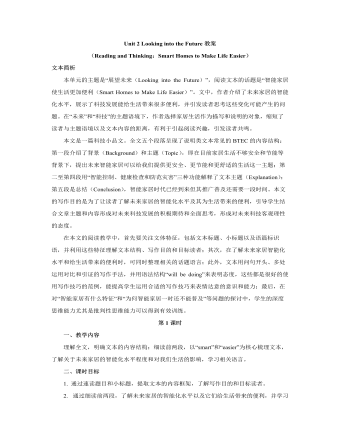
新人教版高中英语选修1Unit 2 Looking into the Future教案
【设计意图】以“新科技是一把双刃剑”为主题开展讨论活动。这个话题比较大,所以给了一定的限制,首先需要以智能家居为例来阐述科技发展对未来生活产生的影响,然后列举其优点和缺点,最后就以上现象发表自己的观点。这个活动是对整个文本的创意性总结与意义的升华,留给学生一定的想象空间,学生借此机会可以运用文本内容和语言表达自己对科技发展的看法和态度。Assignments:1. Finish Exercise 4 on Page 15 of the textbook.A smart home is one that integrated computers into the structure of the building itself. In this way, many of the things that we now do ourselves become automatic. For example, the smart home could control the air conditioning and lights so that you would no longer have to turn switches on and off, and so that your home would be more energy-efficient. The smart home could also monitor itself to make sure that everything is working as it should, and send you warnings if there is a problem. Such smart homes could even be programmed to detect your health problems, and then give you reasonable advice as to the food you should eat or if you should see a doctor. So, in a sense, smart homes will lead us to living smarter lives.2.Create a smart function for your home, and share your creation in the next period.
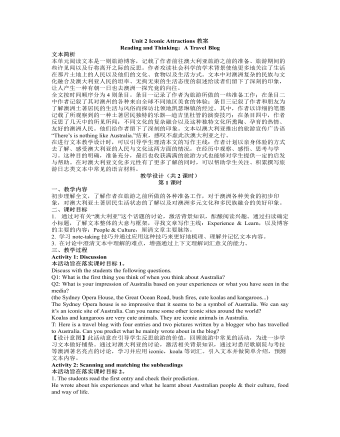
新人教版高中英语选修4Unit 2 Iconic Attractions教案
帮助学生通过讨论与对主题的提升,反思自己的旅游方式,以便做出更优化的安排,在今后的旅程中有更多的收益。 Activity 2: Further discussion of the 6 elements above and supplement of more background knowledge 本活动为实现课时教学目标2。 1.Target Q: The writer’s clear target of traveling, meeting the people and experiencing the culture, is closely related to his major in social studies. Then what is social studies? Social studies is a part of a school or college curriculum concerned with the study of social relationships and the functioning of society and usually made up of courses in history, government, economics, civics, sociology, geography, and anthropology. (Dictionary by Merriam-Webster) Reflection: When you go out to travel, what targets do you usually have in mind? 2.Research Q: Suppose you are traveling to Hangzhou during the school holidays, how will you do research on the city? (surf the internet, read books or travel brochures, consult friends, ...) What information will you be interested to know? (location, iconic sites, local cuisines, interesting customs, shopping malls ...) 3.Abandonment To make the most of time, we have to learn to abandon so that we can accomplish our plan. What will you be interested in doing if you go to Hangzhou if you have a week’s time? What if you only have 2 days? 4~5. Venturing & Experiencing Q: What did he venture to do during the trip? What new experiences did he have? In Sydney: attend his first open-air barbecue, enjoy many different but yummy meals In Catherine: observe the life and customs of the aborigines appreciate their music & try the musical instruments: the didgeridoo
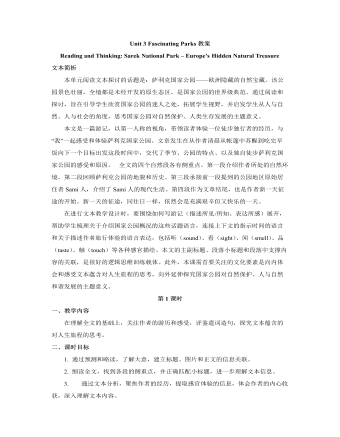
新人教版高中英语选修1Unit 3 Fascinating Parks教案
2. Explore the significance of the establishment of Sarek National Park.Q1: Which event is the most important one in the park’s history?Ss: The establishment of Sarek national park in 1909 is the most important one.Q2: Is it worth making a place like Sarek a national park? Give your reasons.Ss: Yes. In this way, the place can be kept in its natural state and natural beauties and other rare and valuable resources can be preserved instead of being destroyed by endless exploitation driven by profits.Q3: How does the writer organize his introduction to the history of Sarek?Ss: The writer organizes his introduction in the sequence of time, using time indicators such as “used to”, “around 9,000 years ago”, “soon after”, “following the reindeer”, and “in 1909”.Q4: What is the feature of the language used to introduce the history of the park?Ss: The introduction to the park is to provide facts, using time indicators to organize the events. Sentences starts with “third person” and passive voice is used more often, feeling objective.【设计意图】学生寻找和梳理公园历史上的重要事件,体会人与自然的和谐关系,评鉴介绍性语言的特点。【核心素养提升点】发展自主提取、梳理文本信息能力,训练逻辑思维和高阶思维。Activity 3: Highlighting the secret of the text
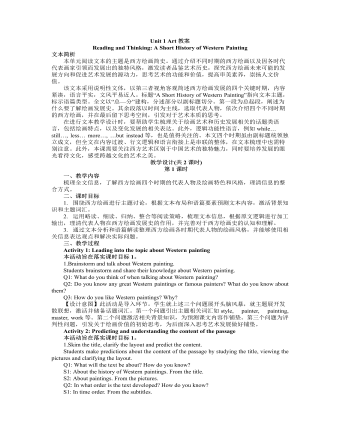
新人教版高中英语选修3Unit 1 Art教案
[2] An important breakthrough…was… [3] Another innovation was … [4] the emphasis increasingly shifted from…to… [5] New ideas and values gradually replaced… [6] While his paintings still had religious themes… … T: All these expressions serve to show how Western painting has developed. Some of them share similar structure but with varied use of words, which makes the text vivid and more readable. 【设计意图】主题类语言整理有助于学生类化语言应用,提高语言输出的丰富性。处理完文本内容信息后,进入语篇信息处理,进行主题相关的词块归类。引导学生快速阅读,寻找表达相同主题(发展或者艺术)的词和短语,再根据词性、用法和结构进行归类,储备主题相关词汇,丰富语言储备,提升语言素养。 Assignment: Go online to gather more information about Chinese painting and write a short history of it. 【设计意图】结合所学,迁移运用,根据实际语境,进行模仿性运用。在此过程中,学生尝试借鉴已学的语言、内容、语篇结构和写作手法来建构新文本,实现语篇输出,同时关注中西艺术文化的差别,加深对优秀文化的认同,培养文化意识。
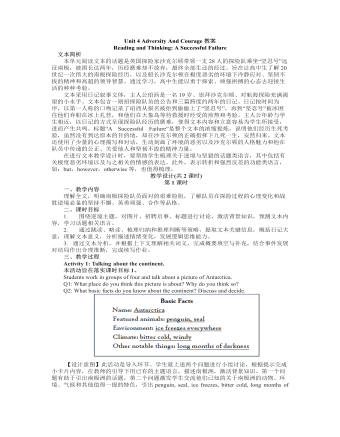
新人教版高中英语选修3Unit 4 Adversity And Courage教案
本活动旨在落实课时目标3。 The Student Union is looking for three students for a 3-week voluntary program in Guizhou province. The volunteers have got to be high school students, with a persevering personality and experiences in overcoming adversity. The volunteers need to stay, eat and teach with 20 pupils in a small school up on the hill of a village. There are no facilities but desks and a blackboard in the school. And there is no take-away food to be bought anywhere; the only way to feed yourself is to cook. You’re interested in applying. Write your application letter introducing what adversity you have ever overcome and how persevering you are as well as what you want to do when at work. Dear Student Union,【设计意图】此任务旨在迁移一、二课时所学,解决实际问题。学生对比自己经历过的挑战或挫折,写信给学生会申请前往贵州担任短期支教教师,把个人以前是怎么战胜挫折的经过书写出来。结合所学,迁移创新,分析解决自身实际问题,在真实情境中学生通过仿写进行主题语言的精确输出。完成任务的过程中,能较多地使用已学语言、内容、结构和写作手法来描述自己面对挫折的处理方式、态度和应有的品质,近一步激发学生树立正确的价值观,学会逆境出人才,坚忍不拔,从容不迫,又做到谦让、分享和合作。课后学生修正习作,再次提交。
- 查看更多相关Word文档
Unit 2 Healthy Lifestyle教案
Readingand Thinking: Climate Change Requires World Attention
文本简析
本单元阅读文本的话题是“健康的生活方式”,旨在帮助学生认识习惯的本质及其运转原理,在此基础上,利用习惯周期,聚焦影响习惯改变的关键因素,尽早识别和改变坏习惯,从而树立积极的生活态度和健康的生活方式,提升识别问题、分析问题和解决问题的意识和能力。
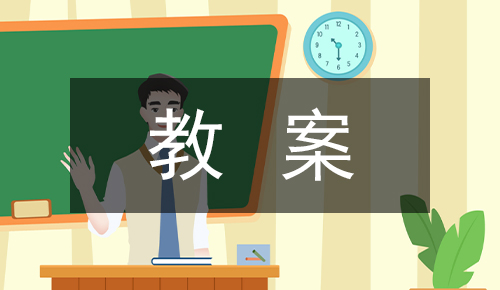
本语篇类型为论说文,兼具议论文和说明文的特征。文本第一段旨在提出问题,作者阐述了坏习惯的危害,并指出青少年应学会尽早识别坏习惯并做出恰当改变。第二、三段旨在分析问题,作者阐明了习惯的内涵,并利用现代心理学知识——“习惯周期”,揭示了习惯的运转原理。第四、五段旨在解决问题,第四段阐述了习惯周期的应用价值,第五段则阐述了改变坏习惯的其他关键因素,包括时间和自律等等。第六段作者重申论说点,并呼吁年轻人认真思考并做出改变,从而建立健康快乐的生活方式。
在进行本文教学设计时,除梳理文本内容和结构外,教师应引导学生积累有关“健康的生活方式”的话题词汇,如physical and mental health, habit, appropriate, alcohol,tobacco, abuse, facilitate, examine, discipline, dominate等。学生学习语言时,应尽可能融合内容的学习及思维的培养。引导学生利用思维导图梳理语篇结构,建构对习惯这一概念及其运转原理的认识,培养其逻辑思维能力,提高学生认识问题、分析问题和解决问题的能力。
第1课时
一、教学内容
整体梳理语篇结构和文本内容,归纳坏习惯的危害,提炼习惯的关键特征,建构对习惯的认识,阐述习惯运转原理,运用“习惯周期”理论分析常见的坏习惯,思考“习惯周期”对改变坏习惯的积极作用。
二、课时目标
1. 通过自主提问,整体阅读文本、梳理语篇宏观结构、明确文本主要内容。
2. 通过归纳坏习惯的危害,树立尽早识别和改变坏习惯的意识,融入tobacco, alcohol, abuse, dominate等语言学习。
3. 提炼习惯的关键特征,包括重复性、选择性、自发性和不易改变性,正确建构习惯的概念。
4. 通过同伴互助,阐述习惯运转原理,运用“习惯周期”分析坏习惯,思考其对改变坏习惯的作用。
三、教学过程
Activity1: Talking about habits and raising questions by students themselves
本活动为实现课时目标1作铺垫。
1.Checkand talk about teenagers’ habits.
Ask studentsto check their own habits and share their opinions on the following questions.
Q1: Haveyou ever checked what habits you have? Make a list of them in one minute.
Q2: Undoubtedly,there are good habits and bad ones in our lists. Do you want to change your badhabits?
(Accordingto students’ different opinions, the teacher writes down the following questionson the blackboard: Should bad habits be changed?)
Q3: Is thereany bad habit you want to change but seemingly impossible to change?
2.Raisequestions by students themselves.
Ask studentsto brainstorm what are needed if we want to change bad habits.
Q1: Today,let’s make what seems impossible possible. To change our bad habits, in your opinion,what do we need to know?
Possibleanswers:
(1)Why arebad habits so difficult to change?
(2)How arebad habits formed?
(3)How canbad habits be changed?
(Accordingto students’ different ideas, the teacher writes the second and the third questionson the blackboard.)
【设计意图】步骤1让学生观察和罗列自身习惯,包括好习惯和坏习惯,并针对是否想要改变坏习惯,是否有想改变坏习惯却似乎改不掉的现象表达自己的观点和看法。在此过程中,教师收集学生最普遍的坏习惯,铺垫语言如abuse, alcohol, tobacco等,从而为后续阅读做好话题和语言上的准备。步骤2针对解决问题,让学生展开自主提问和思考,教师筛选出学生的自主提问,为后续语篇学习提供方向。
Activity2: Figuring out the main idea and the structure of the article
本活动为实现课时目标1。
1.Read tofind out which questions are answered and in which paragraph(s) they are answered.
Ask studentsto read the whole passage and make sure whether the following questions are discussed.If yes, relate the questions with paragraphs.
Q1: Shouldbad habits be changed?
Q2: Howare bad habits formed?
Q3: Howcan bad habits be changed?
(Possibleanswer: Paragraph1 is mainly about the first question, Paragraphs2-3 are about thesecond question while Paragraphs 4-5 are mainly about the last one.)
【设计意图】该活动学生带着问题展开整体阅读,梳理文本主要内容和框架,有助于培养学生的语篇意识。
Activity3: Figuring out whether bad habits should be changed (Paragraph 1)
本活动为实现课时目标2。
1. Readto find out whether bad habits should be changed.
Ask studentsto read Paragraph 1 carefully and underline the supporting evidence.
Q1: Shouldbad habits be changed?
“These badhabits, if left unchecked, could lead to more serious ones when they become adults.”
2. Whatcan be known from “when they become adults”?
(Possibleanswer: “in the long run” or “as time goes by”)
3. Why doesthe author give the example of “tobacco and alcohol abuse” ?
(Possibleanswer: it is to explain “more serious”, which refers to both “physical and mentalhealth problems”)
The teacherthen helps students make a conclusion.
“In a word,bad habits will cause physical and mental health problems in the long run, so theyshould be changed early. Never should teenagers let bad habits ___________theirlife.”
(Possibleanswers: influence, affect (not powerful enough) ; rule, control, dominate)
【设计意图】学生细读第一段,聚焦主要句子,通过分析和推断,提炼出坏习惯应该尽早改正的原因。在语境和观点表达中,体验不同语言的力量,从而感受dominate一词的真正涵义,体会到改变坏习惯的必要性。同时,根据学生回答情况,教师也可融入“健康与快乐”之间的辩证关系。
Activity4: Figuring out how bad habits are formed (Paragraphs 2-3)
本活动为实现课时目标3和4。
1. ReadParagraph 2 and think about the key features of a habit.
Ask studentsto underline the main characteristics of a habit based on their reading.
Q1: Whatcharacteristics does a habit have?
(Possibleanswers: repeatedly, choice, automatic, much harder to change)
Q2: Whyis it hard to change a habit?
Becausewe usually don’t understand how habit works.
2. Workin pairs, read Paragraph 3 and draw out the habit cycle of one of your shared badhabits.
3. Drawa conclusion and think further.
Q1: Is itdifficult for you to understand how habits work?
Q2: Howdoes the author make the habit cycle more accessible to readers?
(Possibleanswers: by giving the definition, by giving a diagram, by giving an example.)
【设计意图】步骤1旨在引导学生分析和概括习惯的主要特征,包括重复性、选择性、自发性和不易改变性,继而针对“不易改变”这一特征展开思考,引出习惯的运转机原理。步骤2通过同伴互助,选择之前分享过的共同需要改变的习惯,通过学习文本,学会自我审视和自我分析。在分享时,教师引导学生解决出现的理解问题,例如reward, routine出现错误的情况,从而正确运用习惯周期。步骤3教师引导学生思考作者如何让抽象的现代心理学理论变得通俗易懂。该活动有助于提升学生的逻辑思维能力,语言表达能力以及理论知识的学习能力。
Assignment
Can thehabit cycle help to change bad habits? If yes, how can it help? Write down yourideas with a specific example of your own habit cycles.
【设计意图】学生选择自己想改变的坏习惯,利用习惯周期展开分析,结合对习惯这一概念及其特征的认识,思考并举例说明习惯周期对改变坏习惯是否有积极作用。该活动旨在检测学生对本课时内容的掌握情况,同时为下一课时的学习作好铺垫与准备。
第2课时
一、教学内容
分析、归纳和提炼改变坏习惯的关键路径和因素,明确作者写作意图,坚定改变坏习惯的信念,并表达采取行动的意愿和措施,从而树立健康的生活方式。
二、课时目标
1. 能提炼和概括习惯改变与养成的关键在于替换习惯周期中的惯常行为,并关注时间、自律和持续努力等其他关键因素,完整回答如何改变坏习惯,融入facilitate, examine, discipline等语言学习。
2. 能提炼语篇完整结构,明确作者写作目的,论述习惯改变与养成的不同方法,坚定改变坏习惯的信心和信念,树立健康的生活方式。
3. 能运用习惯的特征、运转机制、影响因素、改变路径和方法,设计一份中学生某一习惯调查问卷。
三、教学过程
Activity1: Checking the assignment and leading in
本活动为实现课时目标1作铺垫。
1.Reportopinions on whether the habit cycle helps to change bad habits.
Ask students to share their writings in frontof class.
Q: Can thehabit cycle help to change bad habits? If yes, how can it help? Report your ideaswith a specific example of your own habit cycles.
【设计意图】该活动让学生针对第一课时作业发表观点并做课堂展示,一方面能检测学生对第一课时的掌握情况,另一方面借助学生习作回顾课文主要内容,同时能切入第二课时的阅读。
Activity2: Reading to find out the application of the habit cycle (Paragraph 4)
本活动为实现课时目标1。
1.Read towork out the author’s opinion on the application of the habit cycle.
Ask studentsto read Paragraph 4 and figure out what can the habit cycle be used for.
Q1: What’sthe author’s opinion? How do you know that?
“Aside fromchanging bad habits, we can also use the habit cycle to create good ones.”
Q2: What’sthe function of the above sentence?
(Possibleanswer: It concludes the former information and introduces the following.)
Q3: Howcan we facilitate a positive change in our bad habits? “facilitate” means “to makean action or a process possible or easier”.
(Possibleanswer: first examine our bad habit cycles and then try to adapt them.)
Q4: Howdo we adapt bad habits?
By combiningthe information from our habit cycles with our own positive ideas.
Q5: Accordingto the two examples given, what information is changed in the adapted habit cycle,cue, routine or reward? / What should be changed if we want to change bad habits?
The routine.Change the routine, change the bad habits.
【设计意图】引导学生关注段落承上启下的关键句,梳理出段落内结构,从而快速提炼出习惯周期的两种应用。抓住adapt的具体指代及两个例子的共性,提炼出改变坏习惯的关键在于改变习惯周期中的惯常行为(routine),以此提升学生的语言能力和思维能力。
Activity3: Reading to figure out other key factors in changing bad habits
本活动为实现课时目标1。
1.Read Paragraph5 and work out what else are needed to change bad habits.
Q1: Withthe habit cycle, do you think bad habits can be changed right away?
Q2: Whatelse are needed? Read Paragraph 5 and underline the key words.
(Possibleanswer: Changing bad habits also takes time, discipline and repeated efforts.)
Q3: Do youthink you are a person of discipline? Who is more of a person of “discipline” inthe following example?
Both Jamesand John have been trying to get rid of cellphone addict. They were both on theverge of breakdown. James chose to turn to his friends for help and it worked fora while. But John chose to make a clear plan of how long he could play cellphoneseach day and reduce about fifteen minutes at a time. Difficult as it was, he controlledhis own behavior to stay on track.
Therefore,“discipline” means “the ability to control their behavior or the way they live,work, etc”.
Q4: As Laoziwrote, “A journey of a thousand miles begins with a single step”. In your opinion,what is the first single step to break bad habits?
(Possibleanswer: The very willingness and eagerness to live a healthy life.)
2.Make asummary and answer how bad habits can be changed.
Ask studentsto answer the last question raised by themselves.
Q1: How can bad habits be changed?
(Possibleanswer: We should spend a period of time in changing the routine into a healthierone with strong willingness, great discipline and repeated efforts. Gradually, badhabits can be and will be changed.)
【设计意图】通过抓住习惯周期能否让习惯改变立竿见影,引导学生阅读第五段,分析、思考并概括习惯改变的其他关键因素,进一步加深对习惯及其改变的理解,提升逻辑性思维能力。聚焦学生的难点,即对“discipline”的理解,教师运用情境帮助学生理解涵义,从而提升语言能力。借助“千里之行,始于足下”,思考改变坏习惯的最根本最开始的一步,从而与单元主题建立关联,体现主题意义。最后让学生整合第四、五段内容,回答学生提出的最后一个问题——如何改变坏习惯,该活动综合了内容、语言和思维。
Activity4: Figuring out the structure and the writing purpose
本活动为实现课时目标2。
1.Read Paragraph6 and think about its main idea and the writer’s writing purpose.
Q1: If youwere the author, how would you end your article?
“For youngpeople, there is plenty of time to change bad habits. However, there is no “magicpill” or delete button that will help you; you have to think about your bad habitsand decide on some changes. You have the power to build a happy and healthy lifefull of good habits!”
Q2: Whatis Paragraph 6 mainly about?
(Possibleanswer: to appeal to young people including teenagers to change bad habits and livea happy and healthy life.)
2.Thinkabout the writer’s writing purpose and share opinions.
Q1: Whatis the writing purpose? Work in pairs and figure it out.
(Possibleanswer: On the one hand, the passage is written to help teenagers change their badhabits and live a healthy lifestyle. On the other hand, it provides us with a scientificway to identify and analyse our problems objectively, thus strengthening our resolveto tackle the seemingly common yet tough problems in our lives.)
【设计意图】步骤1旨在预测和验证文章最后一段主要内容,梳理完整的语篇结构,步骤2旨在思考和讨论作者的写作目的。教师也可根据学生课堂反应情况融入对语篇人称多次转换的思考。
Activity4: Thinking, reflecting and sharing opinions
本活动为实现课时目标3作铺垫。
转载请注明出处!本文地址:
https://www.lfppt.com/worddetails_6119907.html最新课件教案文档
-
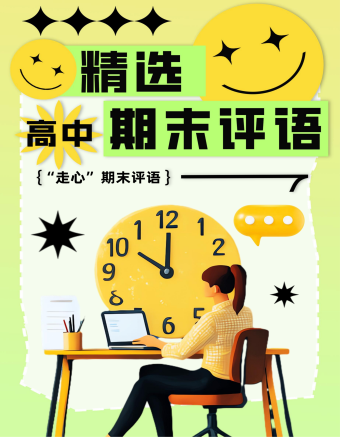
精选高中生期末评语
1、该生学习态度端正 ,能够积极配合老师 ,善于调动课堂气氛。 能够积极完成老师布置的任务。学习劲头足,听课又专注 ,做事更认 真 ,你是同学们学习的榜样。但是,成绩只代表昨天,并不能说明你 明天就一定也很优秀。所以,每个人都应该把成绩当作自己腾飞的起 点。2、 你不爱说话 ,但勤奋好学,诚实可爱;你做事踏实、认真、为 人忠厚 ,是一个品行端正、有上进心、有良好的道德修养的好学生。在学习上,积极、主动,能按时完成老师布置的作业,经过努力 ,各 科成绩都有明显进步,你有较强的思维能力和学习领悟力,学习也有 计划性,但在老师看来,你的潜力还没有完全发挥出来,学习上还要有持久的恒心和顽强的毅力。
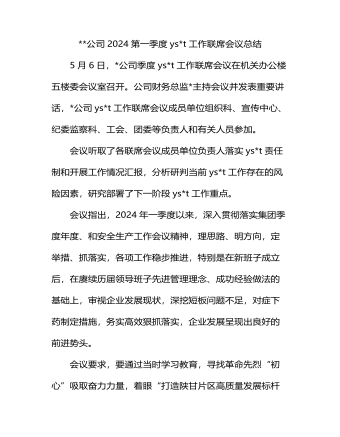
公司2024第一季度意识形态工作联席会议总结
一是要把好正确导向。严格落实主体责任,逐条逐项细化任务,层层传导压力。要抓实思想引领,把理论学习贯穿始终,全身心投入主题教育当中;把理论学习、调查研究、推动发展、检视整改等有机融合、一体推进;坚持学思用贯通、知信行统一,努力在以学铸魂、以学增智、以学正风、以学促干方面取得实实在在的成效。更加深刻领会到******主义思想的科学体系、核心要义、实践要求,进一步坚定了理想信念,锤炼了政治品格,增强了工作本领,要自觉运用的创新理论研究新情况、解决新问题,为西北矿业高质量发展作出贡献。二是要加强应急处事能力。认真组织开展好各类理论宣讲和文化活动,发挥好基层ys*t阵地作用,加强分析预警和应对处置能力,提高发现力、研判力、处置力,起到稳定和引导作用。要坚决唱响主旋律,为“打造陕甘片区高质量发展标杆矿井”、建设“七个一流”能源集团和“精优智特”新淄矿营造良好的舆论氛围。三是加强舆情的搜集及应对。加强职工群众热点问题的舆论引导,做好舆情的收集、分析和研判,把握时、度、效,重视网上和网下舆情应对。
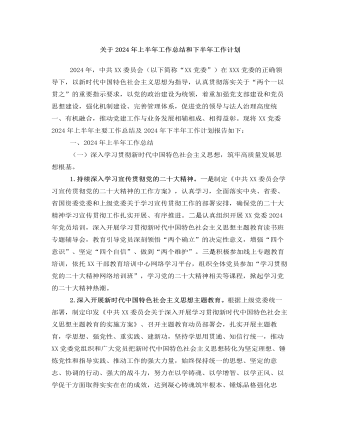
关于2024年上半年工作总结和下半年工作计划
二是深耕意识形态。加强意识形态、网络舆论阵地建设和管理,把握重大时间节点,科学分析研判意识形态领域情况,旗帜鲜明反对和抵制各种错误观点,有效防范处置风险隐患。积极响应和高效落实上级党委的决策部署,确保执行不偏向、不变通、不走样。(二)全面深化党的组织建设,锻造坚强有力的基层党组织。一是提高基层党组织建设力量。压实党建责任,从政治高度检视分析党建工作短板弱项,有针对性提出改进工作的思路和办法。持续优化党建考核评价体系。二是纵深推进基层党建,打造坚强战斗堡垒。创新实施党建工作模式,继续打造党建品牌,抓实“五强五化”党组织创建,广泛开展党员教育学习活动,以实际行动推动党建工作和经营发展目标同向、部署同步、工作同力。三是加强高素质专业化党员队伍管理。配齐配强支部党务工作者,把党务工作岗位作为培养锻炼干部的重要平台。
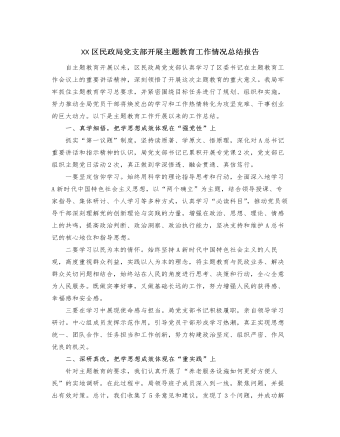
XX区民政局党支部开展主题教育工作情况总结报告
二要专注于解决问题。根据市委促进经济转型的总要求,聚焦“四个经济”和“双中心”的建设,深入了解基层科技工作、学术交流、组织建设等方面的实际情况,全面了解群众的真实需求,解决相关问题,并针对科技工作中存在的问题,采取实际措施,推动问题的实际解决。三要专注于急难愁盼问题。优化“民声热线”,推动解决一系列基层民生问题,努力将“民声热线”打造成主题教育的关键工具和展示平台。目前,“民声热线”已回应了群众的8个政策问题,并成功解决其中7个问题,真正使人民群众感受到了实质性的变化和效果。接下来,我局将继续深入学习主题教育的精神,借鉴其他单位的优秀经验和方法,以更高的要求、更严格的纪律、更实际的措施和更好的成果,不断深化主题教育的实施,展现新的风貌和活力。
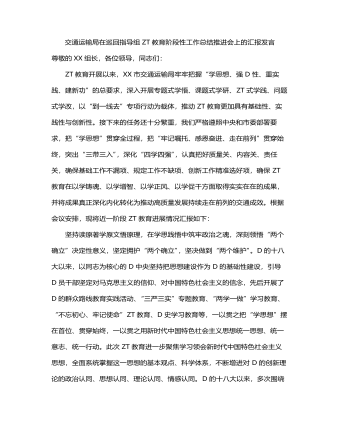
交通运输局在巡回指导组主题教育阶段性工作总结推进会上的汇报发言
今年3月,市政府出台《关于加快打造更具特色的“水运XX”的意见》,提出到2025年,“苏南运河全线达到准二级,实现2000吨级舶全天候畅行”。作为“水运XX”建设首战,谏壁闸一线闸扩容工程开工在即,但项目开工前还有许多实际问题亟需解决。结合“到一线去”专项行动,我们深入到谏壁闸一线,详细了解工程前期进展,实地察看谏壁闸周边环境和舶通航情况,不断完善施工设计方案。牢牢把握高质量发展这个首要任务,在学思践悟中开创建功之业,坚定扛起“走在前、挑大梁、多做贡献”的交通责任,奋力推动交通运输高质量发展持续走在前列。以学促干建新功,关键在推动高质量发展持续走在前列。新时代中国特色社会主义思想着重强调立足新发展阶段、贯彻新发展理念、构建新发展格局,推动高质量发展,提出了新发展阶段我国经济高质量发展要坚持的主线、重大战略目标、工作总基调和方法论等,深刻体现了这一思想的重要实践价值。
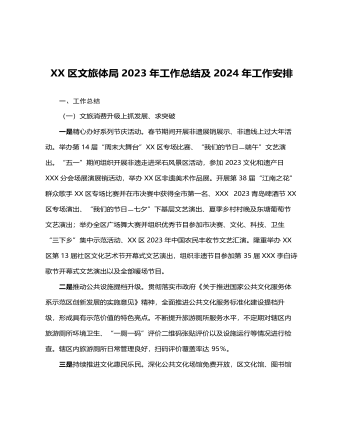
XX区文旅体局2023年工作总结 及2024年工作安排
三、2024年工作计划一是完善基层公共文化服务管理标准化模式,持续在公共文化服务精准化上探索创新,围绕群众需求,不断调整公共文化服务内容和形式,提升群众满意度。推进乡镇(街道)“114861”工程和农村文化“121616”工程,加大已开展活动的上传力度,确保年度目标任务按时保质保量完成。服务“双减”政策,持续做好校外培训机构审批工作,结合我区工作实际和文旅资源优势,进一步丰富我市义务教育阶段学生“双减”后的课外文化生活,推动“双减”政策走深走实。二是结合文旅产业融合发展示范区,全力推进全域旅游示范区创建,严格按照《国家全域旅游示范区验收标准》要求,极推动旅游产品全域布局、旅游要素全域配置、旅游设施全域优化、旅游产业全域覆盖。
今日更新Word
-

精选高中生期末评语
1、该生学习态度端正 ,能够积极配合老师 ,善于调动课堂气氛。 能够积极完成老师布置的任务。学习劲头足,听课又专注 ,做事更认 真 ,你是同学们学习的榜样。但是,成绩只代表昨天,并不能说明你 明天就一定也很优秀。所以,每个人都应该把成绩当作自己腾飞的起 点。2、 你不爱说话 ,但勤奋好学,诚实可爱;你做事踏实、认真、为 人忠厚 ,是一个品行端正、有上进心、有良好的道德修养的好学生。在学习上,积极、主动,能按时完成老师布置的作业,经过努力 ,各 科成绩都有明显进步,你有较强的思维能力和学习领悟力,学习也有 计划性,但在老师看来,你的潜力还没有完全发挥出来,学习上还要有持久的恒心和顽强的毅力。
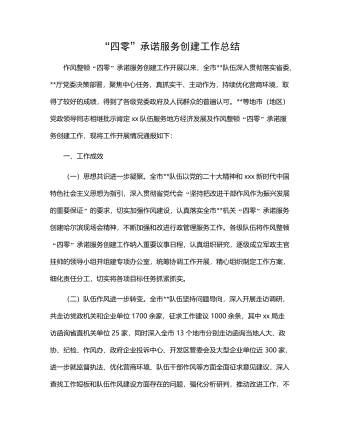
“四零”承诺服务创建工作总结
(二)坚持问题导向,持续改进工作。要继续在提高工作效率和服务质量上下功夫,积极学习借鉴其他部门及xx关于“四零”承诺服务创建工作的先进经验,同时主动查找并着力解决困扰企业和群众办事创业的难点问题。要进一步探索创新,继续优化工作流程,精简审批程序,缩短办事路径,压缩办理时限,深化政务公开,努力为企业当好“保姆”,为群众提供便利,不断适应新时代人民群众对政务服务的新需求。(三)深化内外宣传,树立良好形象。要深入挖掘并及时总结作风整顿“四零”承诺服务创建工作中形成的典型经验做法,进一步强化内部宣传与工作交流,推动全市创建工作质效整体提升。要面向社会和公众庄严承诺并积极践诺,主动接受监督,同时要依托电台、电视台、报纸及微信、微博等各类媒体大力宣传xx队伍作风整顿“四零”承诺服务创建工作成果,不断扩大社会知情面和群众知晓率。
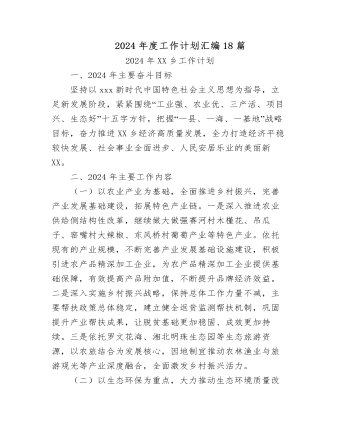
2024年度工作计划汇编(18篇)
1.市政基础设施项目5项,总建设里程2.13km,投资概算2.28亿元。其中,烔炀大道(涉铁)工程施工单位已进场,项目部基本建成,正在办理临时用地、用电及用水等相关工作;中铁佰和佰乐(巢湖)二期10KV外线工程已签订施工合同;黄麓镇健康路、纬四路新建工程均已完成清单初稿编制,亟需黄麓镇完成图审工作和健康路新建工程的前期证件办理;公安学院配套道路项目在黄麓镇完成围墙建设后即可进场施工。2.公益性建设项目6项,总建筑面积15.62万㎡,投资概算10.41亿元。其中,居巢区职业教育中心新建工程、巢湖市世纪新都小学扩建工程已完成施工、监理招标挂网,2月上旬完成全部招标工作;合肥职业技术学院大维修三期已完成招标工作,近期签订施工合同后组织进场施工;半汤疗养院净化和医用气体工程已完成招标工作;半汤疗养院智能化工程因投诉暂时中止;巢湖市中医院(中西医结合医院)新建工程正在按照既定计划推进,预计4月中下旬挂网招标。
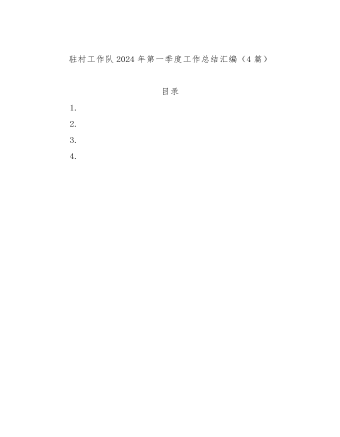
驻村工作队2024年第一季度工作总结汇编(4篇)
三是做大做强海产品自主品牌。工作队于xx年指导成立的冬松村海产品合作社,通过与消费帮扶平台合作,在工作队各派出单位、社会团体、个人支持下,已获得逾xx万元销售额。2022年底工作队推动合作社海产品加工点扩建的工作方案已获批,待资金下拨后将正式启动扩建工作。四是积极助企纾困,带动群众增收致富。工作队利用去年建立的xx镇产业发展工作群,收集本地企业在产品销售、技术、人力、资金、运营、用地等方面的需求,并加大xx支持乡村振兴力度,xx助理赴各村委开展多场xx政策支持乡村振兴宣讲活动,本季度有x万元助农贷款获批,xx万贷款正在审批中。在壮大既有产业的同时,完善联农带农机制,一方面鼓励企业雇用本地农户就业,另一方面计划与本地农户签订长期收购合同,让农民种得放心、种得安心,带动当地群众共同致富。

主题教育总结常用提纲大全
第一,主题教育是一次思想作风的深刻洗礼,初心传统进一步得到回归。第二,主题教育是一次沉疴积弊的集中清扫,突出问题进一步得到整治。第三,主题教育是一次强化为民服务的生动实践,赤子之情进一步得到提振。第四,主题教育是一次激发创业担当的有利契机,发展层次进一步得到提升。2.第一,必须提领思想、武装思想。第二,必须聚焦问题、由表及里。第三,必须领导带头、以上率下。第四,必须务实求实、认真较真。3.一是抬高政治站位,坚持大事大抓。二是坚持思想领先,狠抓学习教育。三是突出问题导向,深入整改纠治。四是坚持领导带头,发挥表率作用。4.一是立足“早”字抓筹划。二是着眼“活”字抓学习。三是围绕“统”字抓协调。5.一是形势所需。二是任务所系。三是职责所在。四是制度所定。6.一要提升认识。二要积极作为。三要密切协作。
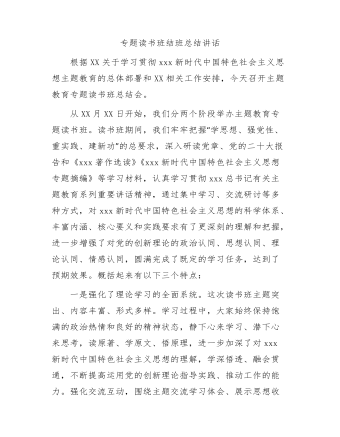
主题教育专题读书班结班总结讲话
第二,要把调查研究贯穿始终,实干担当促进发展。开展好“察实情、出实招”“破难题、促发展”“办实事、解民忧”专项行动,以强化理论学习指导发展实践,以深化调查研究推动解决发展难题。领导班子成员要每人牵头XX个课题开展调查研究,XX月底前召开调研成果交流会,集思广益研究对策措施。各部门、各单位要制定调研计划,通过座谈访谈、问卷调查、统计分析等方式开展调查研究,解决工作实际问题,帮助基层单位和客户解决实际困难。第三,要把检视问题贯穿始终,廉洁奉公树立新风。认真落实公司主题教育整改整治工作方案要求,坚持边学习、边对照、边检视、边整改,对标对表xxx新时代中国特色社会主义思想,深入查摆不足,系统梳理调查研究发现的问题、推动发展遇到的问题、群众反映强烈的问题,结合巡视巡察、审计和内外部监督检查发现的问题,形成问题清单。

















